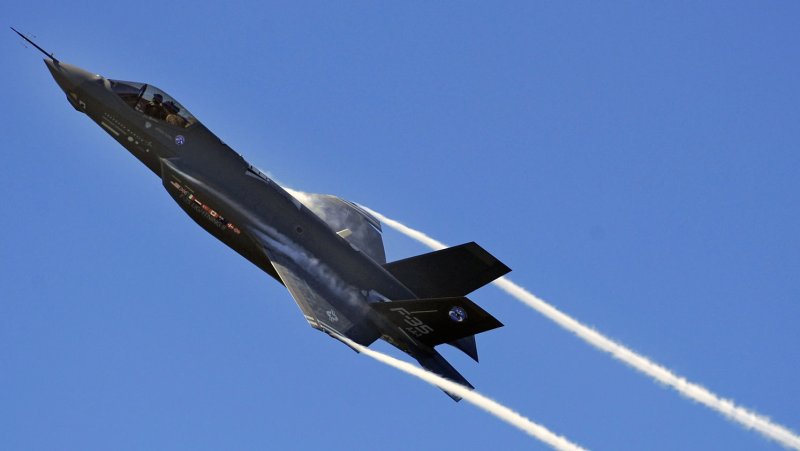An F-35 Lightning II Joint Strike Fighter test aircraft. (UPI Photo/Julianne Showalter/US Air Force) |
License Photo
WASHINGTON, April 1 (UPI) -- The Lockheed Martin F-35 Joint Strike Fighter program continues to trigger new controversies. Latest comments allege flawed estimates of the jet's weight and, as before, questions about the timeline for the plane's delivery and final cost.
Outgoing Executive Vice President and JSF General Manager Tom Burbage was quoted in the news media as saying the manufacturer miscalculated on the aircraft's weight during its early development.
After spending 12 years fronting the Lockheed Martin F-35 program Burbage retired Monday on an optimistic note but still far from clear about the aircraft's ultimate cost and delivery schedule.
Burbage was named head of the F-35 program less than three weeks after the company beat Boeing to develop the aircraft. Then valued at $220 billion, the contract aims to build thousands of F-35 for the U.S. military and hundreds more for international partners, Flight International said on its website.
When those aircraft will roll off to join the waiting military services worldwide remains unclear.
In a Lockheed Martin news conference, Burbage looked back on key lessons that could have been learned and spared the manufacturer a costly redesign and troublesome relations with the program's international partners.
After a 2004 redesign responding to weight concerns that delayed the program two years and cost billions of dollars, Burbage stepped aside from the daily operations and became the F-35's public face marketing the aircraft around the world for the next eight years.
Canada and Japan are in the forefront of countries having second thoughts about the JSF and considering significant cutbacks in their acquisition of the joint strike fighter.
Burbage said he hopes future engineers working on a sixth-generation fighter will heed lessons of the work done so far on the F-35 program.
"Somewhere along the way, we made an error in our parametric weight models," Burbage said.
"Turned out we were predicting the things that we knew about pretty well, the structural parts were pretty close, the small detail parts were pretty close. What wasn't predicted well by the model was stealth and internal weapons bays because the airplane that had those capabilities weren't part of the database."
It could have been as early as 2003 when quick-mate joints -- appliances used to make production faster -- were thrown away to save 1,000 pounds of weight, the Eric Palmer blog said, citing statements made at the time by Burbage and others.
The blog said that during the encounter with reporters, "Burbage made no apologies for his years of misleading Joint Strike Fighter Partner nation government officials about cost and capability of this troubled program."
"The fundamental airplane is going to be there," Burbage told reporters, Defense News said. "It's going to be late, it's going to be more expensive than we thought to do the development, but it's still going to be there, which I think that's the ultimate metric."
"I don't know what the timeline will be," he continued. "I'm hoping that it will be on a reasonable timeline. I think we have a new leadership that's gonna drive the program where it needs to be. It's a new day going forward.
"I think it will happen. I think all three airplanes will be flying in the services, and it's just a question of time, now."
Burbage said running the F-35 program was "more complicated than running some of the business enterprises that are companies."
The program manages thousands of employees, multiple companies and countries worldwide.
He said the decision to develop the F-35 as a joint program with a number of partners led to complications, Defense News said. Geopolitical events outside its control also affected the program, Burbage said.
"Who would have predicted a eurozone crisis for all the international partners in Europe? Who would have predicted the shift to the Middle East and the pivot to the Pacific?" Burbage asked.
The focus on Asia has "actually had a pretty big effect" on the JSF program as a whole, leading to two new partners in Japan and, potentially, South Korea, Defense News said.
Asked how far behind schedule the program was, Burbage said the answer depended on what metric is used, Defense News said. Citing program restructuring in 2010, he said, "I would argue the program post-2010 is not the program pre-2010, modified slightly. It's really a new program."
"The program is so big that a small bump in the road is a big bump in the road," he said, Defense News said.
"It's a tough program. It's technically a very challenging program. This airplane is going to have the capabilities that can transform the joint coalition operational model, and it's going to be effective for a long time."
Burbage sought to keep the international coalition of countries outside the U.S. on track and, where possible, chase new international business, Aviation Week said.
Stephen O'Bryan is working under Burbage as vice president of program integration.
"The departure of Burbage will mark a major shift for the program," Aviation Week said. "He was a polarizing figure for the Joint Strike Fighter. Those staunchly behind him say he provided much of the glue that has kept the international coalition together through thick and thin as the F-35 stumbled through numerous cost overruns, technical problems and delays.
"Those more critical of his contribution suggest that he was at the forefront of Lockheed Martin's aggressive sales campaign that overpromised to customers and has, thus far, under delivered," Aviation Week said.















